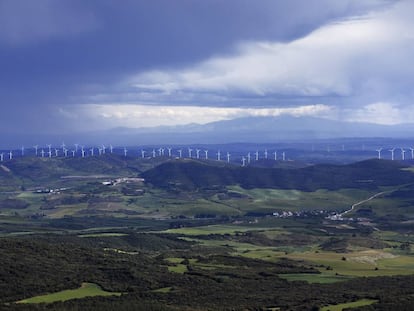Riding high on expanding economy, Spain’s Ibex firms hike profits 16% in 2017
Santander, BBVA and other companies increased revenues and reduced debt levels as national output reached 3.1%


With an economy that’s been growing for 17 consecutive quarters (see side box), businesses in Spain have made the most of it by reducing their debt levels – or “deleveraging” – and improving their margins.
Accumulated profit for 34 of the 35 companies listed on the Ibex 35 (Inditex, the parent company of Zara, ends its fiscal year two months later) reached €40.1 billion in 2017, a 16.26% rise from the previous year.
Santander, the eurozone’s largest bank by market capitalization, topped the profit chart
And these large companies also earned 7.6% more than in 2016, achieving revenues of nearly €474.2 billion. To put this figure in perspective, it is the same as the entire expenditure of all of Spain’s public agencies put together.
The collective rise in profit reflects a corporate policy of cost adjustment and margin optimization in recent years.
The figures were compiled by the Spanish securities watchdog, the Comisión Nacional del Mercado de Valores (CNMV).
Santander, at the top
Santander, the eurozone’s largest bank by market capitalization, topped the Ibex 35’s net profit chart with €6.6 billion, up 6.68% from 2016. But ArcelorMittal posted the biggest revenue, at just over €56 billion.
Other top performers include the lender BBVA, which made a profit of €3.5 billion, and Telefónica (€3.1 billion). Acerinox posted the largest profit increase of all (191.5%) to reach €234 million. Meanwhile, ArcelorMittal and the real estate group Colonial grew their revenues by 156% and 149%, respectively.
At the bottom of the list are the engineering firm Técnicas Reunidas and the supermarket chain Dia, whose profits fell 69.3% and 37% respectively last year.
GDP grew 3.1% in 2017
The Spanish economy ended 2017 with growth of 3.1%, according to figures released on Thursday by the National Statistics Institute (INE). Growth experienced a slight slowdown in the last quarter, coming in at 0.7%, one-tenth of a point lower than in the July-September period. Domestic demand was the main driver of this growth in the last three months of the year, whereas exports lost some of their strength. Spain’s GDP was nearly €1.2 trillion, a historic high after four consecutive years of growth.
English version by Susana Urra.
Tu suscripción se está usando en otro dispositivo
¿Quieres añadir otro usuario a tu suscripción?
Si continúas leyendo en este dispositivo, no se podrá leer en el otro.
FlechaTu suscripción se está usando en otro dispositivo y solo puedes acceder a EL PAÍS desde un dispositivo a la vez.
Si quieres compartir tu cuenta, cambia tu suscripción a la modalidad Premium, así podrás añadir otro usuario. Cada uno accederá con su propia cuenta de email, lo que os permitirá personalizar vuestra experiencia en EL PAÍS.
¿Tienes una suscripción de empresa? Accede aquí para contratar más cuentas.
En el caso de no saber quién está usando tu cuenta, te recomendamos cambiar tu contraseña aquí.
Si decides continuar compartiendo tu cuenta, este mensaje se mostrará en tu dispositivo y en el de la otra persona que está usando tu cuenta de forma indefinida, afectando a tu experiencia de lectura. Puedes consultar aquí los términos y condiciones de la suscripción digital.
More information
Archived In
Últimas noticias
A survivor’s account of the Interoceanic Train accident: ‘We were scared because of the speed on the curve’
The Interoceanic Train, the Mexican alternative to the Panama Canal
What is known about the Interoceanic Train derailment in Oaxaca
Trump turns a Minnesota fraud allegation into ammunition for his MAGA army against Democrats
Most viewed
- Oona Chaplin: ‘I told James Cameron that I was living in a treehouse and starting a permaculture project with a friend’
- Reinhard Genzel, Nobel laureate in physics: ‘One-minute videos will never give you the truth’
- Why the price of coffee has skyrocketed: from Brazilian plantations to specialty coffee houses
- Pablo Escobar’s hippos: A serious environmental problem, 40 years on
- Chevy Chase, the beloved comedian who was a monster off camera: ‘Not everyone hated him, just the people who’ve worked with him’










































